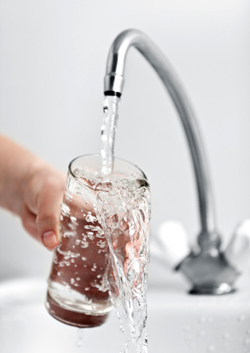Fluoride isn’t the only chemical in drinking water to get national attention lately.
The EPA has been under fire because of widespread contamination of atrazine–one of the most commonly used weed-killers in the United States. How widespread? Chances are if you live in the U.S. it’s in your water now.
The chemical has been shown to cause environmental damage and is hazardous to wildlife, especially amphibians. It is also a known endocrine disruptor in humans, resulting in a host of cancers, reproductive issues, birth defects and more.
That was enough for Italy and Germany to ban the chemical in 1991… and the EU to follow suit in 2004… yet the EPA is still sitting on their thumbs.
But, you don’t have to sit on YOUR thumbs. There are several things you can do to protect yourself and your family from the negative effects of atrazine… starting with education.
What You Need to Know About Atrazine
Atrazine is one of the most commonly used weed-killers in the U.S. today, with approximately 76.5 million pounds applied yearly.
Farmers prefer it for its economy and power: it controls a wide range of weeds for relatively low cost. It is used on corn, sugarcane and sorghum, as well as on golf courses and lawns. You may be surprised by one of the most heavily contaminated states: Delaware. Right up there with Midwestern agricultural states Iowa, Illinois, Indiana, Ohio and Nebraska according to the EPA’s own statistics.
Due to its slow half-life and biodegradability, atrazine is easily spread by rainfall and runoff from the crops. The chemical is found in 75% of stream water, 40% of groundwater and 80% of public drinking water supplies across the Midwest and Southern U.S.
The Politics of Health
The EPA, with respect to the 1974 Safe Drinking Water Act, promised that no more than 3 parts per billion of the chemical would be found in any water sample. (That’s about three tablespoons in an Olympic sized swimming pool.)
This standard is ten times below the levels scientists have found harmful in animal tests–but ignores the hazards of chronic, low-dose exposure.
Of course, the EPA hasn’t kept their end of the bargain. In 2010, the EPA failed to notify citizens of at least four states in the Midwest that the atrazine levels were higher than regulations–above 30ppb.
Sixteen cities filed a federal lawsuit against atrazine manufacturer Syngenta, demanding they pay for the cost of filtering the chemical from their water supply. The cities settled in 2012 for a $105 million filtration process–less than half of what they had already spent.
How to Protect Yourself from Atrazine
While the government continues to allow our water to be contaminated, there are several things you can do to protect yourself and your family.
1. Filter Your Water
With all the options available, choosing the best water filter can be confusing. The bottom line is that any filter is better than no filter. Drinking straight from a tap opens your body up to organic and inorganic compounds, impurities, additives like chlorine and fluoride, cysts, sediment, metals and microparticles like rust.
The EPA recommends using an “activated carbon filter” for removing trace atrazine in your drinking water. These are your standard, relatively inexpensive filters you can attach to your faucet or put in a pitcher. However, carbon filters are known to develop “streams” through the filter where water can escape filtration.
A reverse osmosis system may provide more thorough filtration for herbicides. It also removes lead, mercury, fluoride and cysts. Distillation (boiling) will also remove up to 99% of contaminants.
One of my favorite filters are the Berkey line of water purification systems. These not only remove bacteria, heavy metals and chemicals including atrazine like the reverse osmosis and distillation methods will, but have the added benefit of NOT de-mineralizing your drinking water which may have negative long-term effects on your bone density.
2. Sign the Petition
Bills banning atrazine have been in and out of the House of Representatives since 2008, championed by Rep. Keith Ellison, but have never gone further than the House floor.
Help Rep. Ellison pass H.R. 2044 by signing the petition to ban atrazine. There’s no excuse for having any form of contamination in our drinking water supply.
You can view and sign the petition here.
3. Build Up Your Daily Defenses
You may be exposed to environmental toxins like atrazine on a daily basis through your drinking water. The best way to fight the harmful effects is on a daily basis, too.
Probiotics, proteolytic enzymes and cleansing herbs are some of the best–and gentlest–ways to reverse damage and prevent future health problems from toxins. Help your body defend itself by flushing toxins out of your bowels blood. Our all natural Natural Cleanse and Heal-n-Soothe® help you do both. With daily use, you’ll be able to effectively fight constant exposure to these environmental contaminants.
References
Wu M. Still Poisoning the Well: Atrazine Continues to Contaminate Surface Water and Drinking Water in the United States. The Natural Resources Defense Council. 2010 April.
Atrazine Interim Reregistration Eligibility Decision (IRED) Q&A. United States Environmental Protection Agency. 2012 May 9.
Ivory D. 16 Cities Sue Manufacturer of Atrazine Weed-Killer For Contaminating Drinking Water. Huffington Post Investigative Fund. 2011 May 25.
Mergel M. Atrazine Regulation in Europe and the United States. A Small Dose of Toxicology: the Health Effects of Common Chemicals. Healthy World Press. 2010 Jun. 14.
Berkey Filters. Frequently Asked Questions About Berkey Water Filters. 1998.


